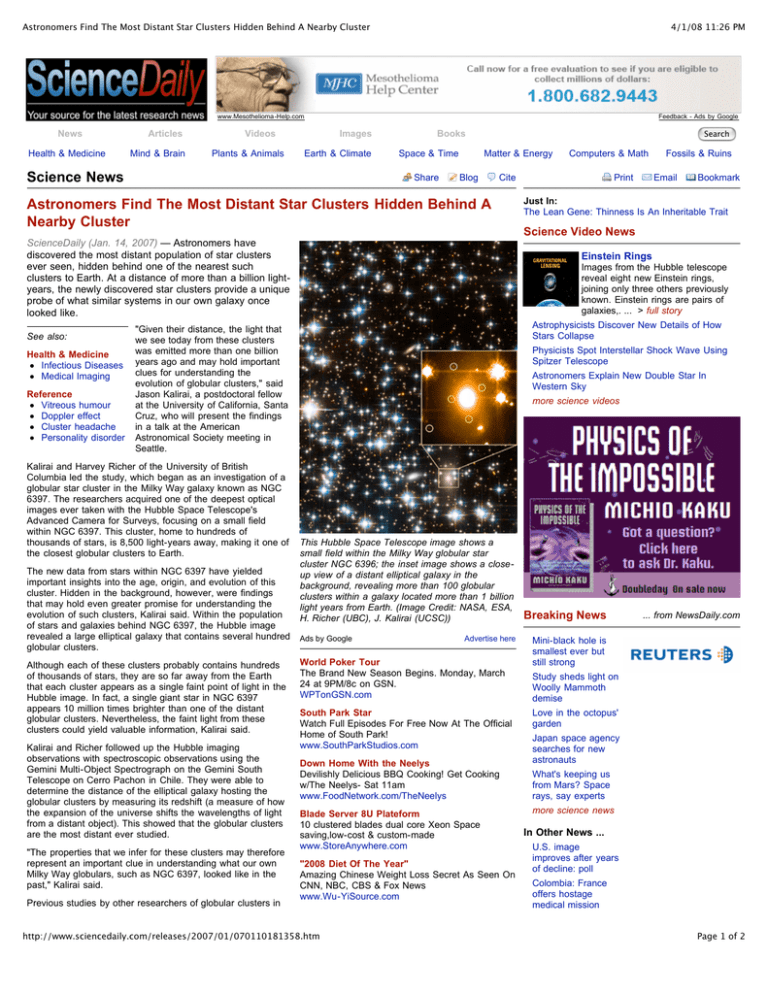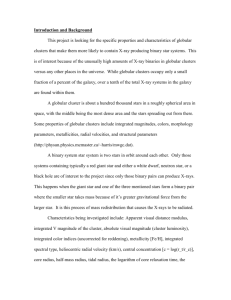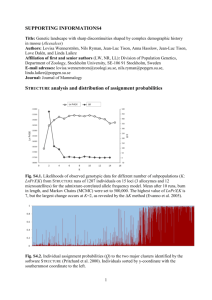
Astronomers Find The Most Distant Star Clusters Hidden Behind A Nearby Cluster
4/1/08 11:26 PM
www.Mesothelioma -Help.com
News
Health & Medicine
Articles
Mind & Brain
Videos
Plants & Animals
Feedback - Ads by Google
Images
Earth & Climate
Science News
Books
Space & Time
Share
Search
Matter & Energy
Blog
Cite
Astronomers Find The Most Distant Star Clusters Hidden Behind A
Nearby Cluster
ScienceDaily (Jan. 14, 2007) — Astronomers have
discovered the most distant population of star clusters
ever seen, hidden behind one of the nearest such
clusters to Earth. At a distance of more than a billion lightyears, the newly discovered star clusters provide a unique
probe of what similar systems in our own galaxy once
looked like.
See also:
Health & Medicine
Infectious Diseases
Medical Imaging
Reference
Vitreous humour
Doppler effect
Cluster headache
Personality disorder
The new data from stars within NGC 6397 have yielded
important insights into the age, origin, and evolution of this
cluster. Hidden in the background, however, were findings
that may hold even greater promise for understanding the
evolution of such clusters, Kalirai said. Within the population
of stars and galaxies behind NGC 6397, the Hubble image
revealed a large elliptical galaxy that contains several hundred
globular clusters.
Although each of these clusters probably contains hundreds
of thousands of stars, they are so far away from the Earth
that each cluster appears as a single faint point of light in the
Hubble image. In fact, a single giant star in NGC 6397
appears 10 million times brighter than one of the distant
globular clusters. Nevertheless, the faint light from these
clusters could yield valuable information, Kalirai said.
Kalirai and Richer followed up the Hubble imaging
observations with spectroscopic observations using the
Gemini Multi-Object Spectrograph on the Gemini South
Telescope on Cerro Pachon in Chile. They were able to
determine the distance of the elliptical galaxy hosting the
globular clusters by measuring its redshift (a measure of how
the expansion of the universe shifts the wavelengths of light
from a distant object). This showed that the globular clusters
are the most distant ever studied.
"The properties that we infer for these clusters may therefore
represent an important clue in understanding what our own
Milky Way globulars, such as NGC 6397, looked like in the
past," Kalirai said.
Previous studies by other researchers of globular clusters in
Print
Fossils & Ruins
Email
Bookmark
Just In:
The Lean Gene: Thinness Is An Inheritable Trait
Science Video News
Einstein Rings
Images from the Hubble telescope
reveal eight new Einstein rings,
joining only three others previously
known. Einstein rings are pairs of
galaxies,. ... > full story
Astrophysicists Discover New Details of How
Stars Collapse
"Given their distance, the light that
we see today from these clusters
was emitted more than one billion
years ago and may hold important
clues for understanding the
evolution of globular clusters," said
Jason Kalirai, a postdoctoral fellow
at the University of California, Santa
Cruz, who will present the findings
in a talk at the American
Astronomical Society meeting in
Seattle.
Kalirai and Harvey Richer of the University of British
Columbia led the study, which began as an investigation of a
globular star cluster in the Milky Way galaxy known as NGC
6397. The researchers acquired one of the deepest optical
images ever taken with the Hubble Space Telescope's
Advanced Camera for Surveys, focusing on a small field
within NGC 6397. This cluster, home to hundreds of
thousands of stars, is 8,500 light-years away, making it one of
the closest globular clusters to Earth.
Computers & Math
Physicists Spot Interstellar Shock Wave Using
Spitzer Telescope
Astronomers Explain New Double Star In
Western Sky
more science videos
This Hubble Space Telescope image shows a
small field within the Milky Way globular star
cluster NGC 6396; the inset image shows a closeup view of a distant elliptical galaxy in the
background, revealing more than 100 globular
clusters within a galaxy located more than 1 billion
light years from Earth. (Image Credit: NASA, ESA,
H. Richer (UBC), J. Kalirai (UCSC))
Ads by Google
Advertise here
World Poker Tour
The Brand New Season Begins. Monday, March
24 at 9PM/8c on GSN.
WPTonGSN.com
South Park Star
Watch Full Episodes For Free Now At The Official
Home of South Park!
www.SouthParkStudios.com
Down Home With the Neelys
Devilishly Delicious BBQ Cooking! Get Cooking
w/The Neelys- Sat 11am
www.FoodNetwork.com/TheNeelys
Blade Server 8U Plateform
10 clustered blades dual core Xeon Space
saving,low-cost & custom-made
www.StoreAnywhere.com
"2008 Diet Of The Year"
Amazing Chinese Weight Loss Secret As Seen On
CNN, NBC, CBS & Fox News
www.Wu-YiSource.com
http://www.sciencedaily.com/releases/2007/01/070110181358.htm
Breaking News
... from NewsDaily.com
Mini-black hole is
smallest ever but
still strong
Study sheds light on
Woolly Mammoth
demise
Love in the octopus'
garden
Japan space agency
searches for new
astronauts
What's keeping us
from Mars? Space
rays, say experts
more science news
In Other News ...
U.S. image
improves after years
of decline: poll
Colombia: France
offers hostage
medical mission
Page 1 of 2
Astronomers Find The Most Distant Star Clusters Hidden Behind A Nearby Cluster
4/1/08 11:26 PM
medical mission
nearby galaxies, including the Milky Way, have shown that
these systems play a very important role in understanding the
formation and evolution of galaxies. With a sample of almost
200 clusters in this one distant galaxy, Kalirai's team will test
whether the properties of these globulars are consistent with
the idea that elliptical galaxies formed the bulk of their stars
at early times. For the first time, the observations may also
allow astronomers to test for evolution in the properties of
globular clusters themselves, Kalirai said.
Related Stories
In addition to Kalirai and Richer, the team involved in this
research includes Jay Anderson of Rice University and Jay
Strader and Kieran Forde of UC Santa Cruz. This work was
supported by NASA through a Hubble Fellowship grant
awarded by the Space Telescope Science Institute to Kalirai.
Support for this work was also provided by a grant from
NASA/STScI, the Natural Sciences and Engineering Research
Council of Canada, and the Canada-U.S. Fulbright Program
through the award of a Fulbright Fellowship to Richer.
The Growing-up Of A Star (Feb. 4,
2008) — Using ESO's Very Large
Telescope Interferometer, astronomers
have probed the inner parts of the disc
of material surrounding a young stellar object,
witnessing how it gains its mass before becoming
... > read more
Adapted from materials provided by University of California Santa Cruz.
Need to cite this story in your essay, paper, or report?
Use one of the following formats:
APA
MLA
University of California - Santa Cruz (2007,
January 14). Astronomers Find The Most
Distant Star Clusters Hidden Behind A Nearby
Cluster. ScienceDaily. Retrieved April 1, 2008,
from http://www.sciencedaily.com
/releases/2007/01/070110181358.htm
Chandra Probes Nature Of Dark Matter (Sep.
14, 2001) — Scientists have precisely determined
the distribution of dark matter in a distant galaxy
cluster with NASA's Chandra X-ray Observatory.
These new measurements serve to narrow the
field of ... > read more
The Invisible Galaxies That Could
Not Hide (Feb. 22, 2006) —
Astronomers, using the unique
capabilities offered by the highresolution spectrograph UVES on ESO's Very
Large Telescope, have found a metal-rich
hydrogen cloud in the distant universe. The result
... > read more
Bush wants NATO
to welcome
European
democracies
Bush vows to press
for Ukraine, Georgia
in NATO
Some homes worth
less than their
copper pipes
FAA issues landing
gear alert: report
Iraqi casualties at
highest level since
mid-2007
Necklace is oldest
gold artifact in the
Americas
more top news
Copyright Reuters 2008. See Restrictions.
Mining For Gems In The Fungal Genome (Jan.
... from ScienceDaily
Free Subscriptions
24, 2006) — Ever since penicillin, a byproduct of a
fungal mold, was discovered in 1929, scientists
Get the latest science news with our free email
have scrutinized fungi for other breakthrough
newsletters, updated daily and weekly. Or view
drugs. As reported Jan. 20 in the Journal of
hourly updated newsfeeds in your RSS reader:
Chemistry and ... > read more
Email Newsletters
Looking Into Space Is Good For The Eye (Oct.
RSS Newsfeeds
3, 2006) — Telescopes have helped the naked
eye see into space for hundreds of years. Now
... we want to hear from you!
Feedback
imaging technology developed to correct telescopic
images of far-flung planetary systems is directly
Tell us what you think of the new ScienceDaily -benefiting research ... > read more
we welcome both positive and negative comments.
Have any problems using the site? Questions?
Search ScienceDaily
Number of stories in archives: 44,032 Your Name:
Find with keyword(s):
Search
Your Email:
Comments:
Enter a keyword or phrase to search ScienceDaily's archives for related news topics,
the latest news stories, reference articles, science videos, images, and books.
Ads by Google
Advertise here
Automatic Litter Box
The Automatic Litter Box that
Really Works. 5 Star Rating!
litter-robot.com
Place Card Holders
Hearts, Spheres, Stars and Shells
Vases, Crowns, All Themes
AdvantageBridal.com
Change The Game -21 Movie
Feel the rush of high stakes action
Get the 21 Movie soundtrack here!
www.amazon.com/21themovie
Click button to submit feedback:
Send It
About This Site | Editorial Staff | Awards & Reviews | Contribute News | Advertise With Us | Privacy Policy | Terms of Use
Copyright © 1995-2008 ScienceDaily LLC — All rights reserved — Contact: editor@sciencedaily.com
http://www.sciencedaily.com/releases/2007/01/070110181358.htm
Page 2 of 2







